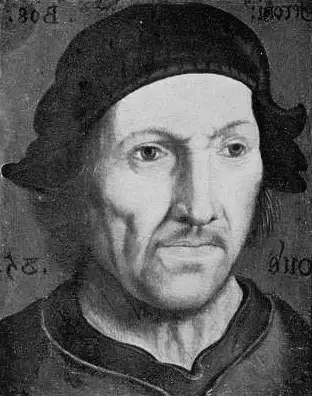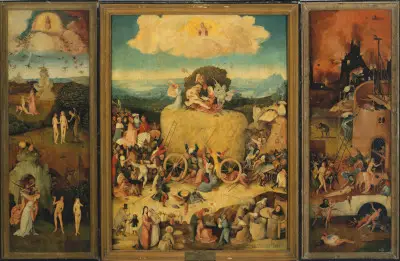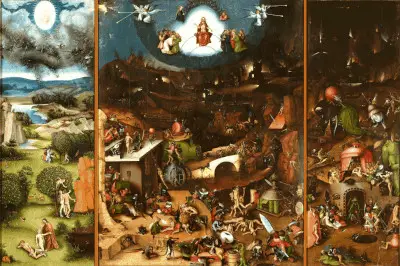Netherlandish artist Hieronymus Bosch followed his own artistic path during the Dutch Renaissance, producing attention grabbing paintings which were out of sync with the North European artists of the 15th and 16th centuries
Introduction
Hieronymus Bosch was a painter of dreams, and nightmares. Instead of depicting nature as we all see it, this was an artist who would create stunning scenes of activity based on religious passages, adding his own imagination and technical ability. The inventiveness of Bosch was to impress art followers across Europe during and beyond his lifetime, but many were uncomfortable with the scary creatures depicted in many of his paintings.
The 15th and 16th centuries were far less open to new artistic directions than the art public that we have today are, and so this Netherlandish painter would not follow a smooth path of attaining academic respect for his art works. Further famous Dutch art would be contributed by Vermeer and Rembrandt.
A clear contrast can be made between the styles of Bosch and famous artists of that era such as Albrecht Durer, who concentrated on animal depictions, flowers and portrait etchings. Indeed, Durer, more of a true Renaissance artist in style, was to imply that Bosch was a "painter of dreams" in one of his own books.
Little was known about the man behind the paintings for several centuries after his career, but what we do now know is that Hieronymus Bosch was to become a significantly respected individual in his local region of 's-Hertogenbosch as a result of his work. He was to rise to the elite ranks of social circles after being backed by several notable patrons.
We can conclude as to Bosch's detailed knowledge of the Bible and Christian beliefs as well as religious symbolism, due to the content found in his paintings. There is therefore considerable thought that has gone into his art, rather than wild fantasies being outputted onto canvas. The grotesque creatures of Bosch's art were to encourage others in future generations, with Dutchman Pieter Bruegel and Spaniard Francisco de Goya among those who used similar themes in their own artistic content.
There have been wide ranging opinions on Bosch from a variety of sources over recent centuries but it is generally accepted that the artist aimed to use his art to teach moral and spiritual lessons to others. This was common at that time within Northern Renaissance art and literature, see also Albrecht Durer.
Typical of artists from the 15th and 16th centuries, there are not that many art works remaining from Bosch's career, with many other of those that have been confidently attributed to him having fallen into considerable disrepair. It is also likely that Hieronymus was not the most productive of artists anyway, and would put a lot of time into several large scale triptych altarpieces.
Compare that to the likes of Raphael, da Vinci and Michelangelo Buonarroti who produced endless streams of high quality work over many decades. Several members of Hieronymus's family had artistic links, including his father Anthonius van Aken. It is likely that either his father or uncles had taught him to paint, but there is no real evidence to confirm this.
The family also had held links to the Illustrious Brotherhood of Our Blessed Lady and this continued with Hieronymus. There are many symbols and themes of religious influence to be found in his work. The Garden of Earthly Delights is an oil on oak triptych from between 1490 and 1510, and also Hieronymus Bosch's most famous painting.
Where was Hieronymus Bosch from?
Jheronimus van Aken was born in 's-Hertogenbosch, Duchy of Brabant, Burgundian Netherlands. 's-Hertogenbosch is today known as Den Bosch, a thriving city in the province of North Brabant (read more in our biography).
The country itself has undergone many transformations over the past few centuries and what was once known as Burgundian Netherlands lasted only from 1384 to 1482 and was a collection of various regions owned by a powerful French family. By the time of his death in 1516, the Duchy of Brabant was now a part of the Habsburg Netherlands, underlining the frequent changes found in this part of Northern Europe around that time.
Today, the city lies in the south of modern-day Netherlands and has also contributed a number of other famous artists and musicians, though none have managed to achieve the same levels of worldwide fame as Bosch has done.
In which Period did the artist Appear?
The artist was born in around 1450, but no clear documentation is available to give a conclusive date. He lived until 1516, meaning his career stretched across the late 15th century through to the early 16th century. This period has generally been termed as the Early Netherlandish, which was a part of the wider Northern Renaissance. This was an era of great innovation, a time when artists started to move out of the medieval period and begin to evolve European culture.
Advancements would be made in literature, architecture, music and the visual arts, with Italy and Northern Europe leading the way initially. Later on, other regions such as France, Spain and the UK would follow suit. Bosch came a little after Jan van Eyck and a little before Albrecht Durer, with those three playing a crucial role within the innovations of the Northern Renaissance. Following on from these great names, there was also Pieter Bruegel who himself played a significant role in promoting the artistic qualities of this region.
What was his Artistic Style?
Hieronymus Bosch's style is perhaps best known for two clear attributes, firstly the bright tones of colour which were unusual for the time, and also the wierd and wonderful creatures that started to appear within his work as his career developed. Many of the themes that Bosch took on were entirely typical of the period, but he was able to take them in new directions thanks to the innovative manner of his work.
Extraordinary creations from the depths of his mind would embellish various panel paintings, with some exquisite detail adorning a number of his larger projects. The use of multi-panel works then allowed him to cover different themes with considerable contrasts from one to the next, whilst still achieving a level of consistency across the overall display. Bosch seemed to most enjoy inventing these wild characters and found that the Bible offered him plenty of opportunities for innovating, even though it's passages had already been visualised within art for many centuries before.
For few artists is it more necessary to see their work in person than Bosch, because of the large scale of some of his panel pieces, and the need to drill down into specific areas of these sprawling displays of creativity and technical brilliance.
"...For poor is the mind that always uses the ideas of others and invents none of its own..."
What made Hieronymus Bosch so Famous?
Bosch is seen by some as from the Late Gothic era, and by others as from the Early Renaissance. He was classed as a painter of dreams, and this niche allowed him to combine all manner of different objects together in a way that would not have been possible any other way.
It would be Bosch's imagination that helped him to achieve such fame, as his technical work, as impressive as it was, did not quite meet the standards of the likes of Van Eyck. Indeed, even individual figures within his sprawling artworks continue today to impress, inspire and excite scholars and designers, leading to some of his larger designs being deconstructed in forensic detail. Despite falling out of favour until the 19th century, his resurrection coincided with a greater openness within European art, and so perhaps he was too much for many from previous centuries.
The bright tones have also been more suited to the contemporary art world. Perhaps in a similar manner to Goya, the shocking and exciting content which produced memorable contrasts would ensure a unique point of difference which enabled these two artists to achieve a particularly prominent place within the public's memory.
What were the Themes of Bosch's Paintings?
Bosch themed many of his artworks around morality, sectioning compositions into perdition and paradise. He would follow in the manner of the day by incorporating religious subjects but did so in a style that was innovative. Emotion played a major role in his paintings, as he incorporated expressive brushwork and shocking scenes with grotesque figures.
The artist would use elements of symbolism within his art, but did so in a subtle manner which has caused historians to debate the meanings of his creations for many centuries. It may have been that some of Bosch's commentary would have landed him in trouble, and so he was forced to deliver meaning in a more vague way, hoping that those he wanted to reach out to could understand his message.
The region of the Netherlands in which he lived was under forced occupation at the time by rulers who also paid the artist for various projects, making it awkward for him to speak out politically on matters such as this. The drama found within Heaven and Hell provides the perfect example of his common approach in the latter part of his career, as he became bolder and more ambitious.
What Triptychs did he Produce?
Hieronymus Bosch produced more than half a dozen triptchs during his lifetime, and potentially even more that have been lost in the years since. He would typically paint both sides of the foldable structure, so that there was something to see whether the side panels were folded in or open.
It also allowed the artworks to be displayed in different manners, either against a wall or in the middle of a room. The format required a central panel that would normally be the same height as the side panels, but wider. The main theme would be added to this central piece, with related, supporting content then added either side.
The Garden of Earthly Delights, for example, has The Creation of the World on its outer panels, whilst Adoration of the Magi has Saint Gregory's Mass on its reverse. Other triptychs to look out for include Hermit Saints, The Martyrdom of St. Julia, The Temptation of St Anthony and The Haywain. There was also two different versions of The Last Judgement, one from 1495–1505 and one from 1500-1505.
Finally, there is the Passion Triptych which can today be found in Valencia and dates from around 1530, and potentially from a follower of the artist. The extraordinary level of detail used by Bosch within the panel paintings ensures that many have studied each panel individually, reducing these complex designs into characters and themes.
Where can Bosch's Art be Found Today?
Hieronymus Bosch's artworks are today spread right across the world. Original items from his career can be found all across Europe, plus Australia, Canada, New Zealand and the US. It is the Museo del Prado in Madrid, Spain which offers the best coverage of his career, with a number of very famous triptychs to be found here.
The UK and US have only very few items, with the rest very thinly spread. This has made it hard to bring together all of these works for comprehensive exhibitions on his oeuvre, particularly when considering the fragility of some of these paintings and drawings. Some recent publications, however, have made a good attempt at documenting the different elements together and allowing us to compare everything within the same publication.
Visitors to the Prado Museum in Spain will find a room dedicated to the artist, with a breathtaking display of some of his finest works sat close to each other. Most will visit expecting to see the finest Spanish art, which they will indeed find here, but for many it is the inclusion of Bosch's paintings that are the true highlight.
What were his Most Famous Paintings?
The Garden of Earthly Delights will always remain Hieronymous Bosch's most famous painting, enjoying a prominent role within the collection of the Prado Museum in Madrid, Spain. It's detailed panels have been examined closely for many centuries and most consider it to have been amongst the finest creations within the Northern Renaissance.
But if we look beyond it, what other artworks could be considered amongst his most famous? There were several other triptychs that can be considered of a similar standard, such as The Last Judgment, The Haywain and Adoration of the Magi, followed by a large number of individual panel pieces which form an impressive body of work.
There has been so much interest in his paintings that many have actually reduced some of these complex triptychs down to individual figures and characters, many of which come directly from the artist's own imagination. The Prado remains the best location to see more about his career, because of how it serves up a number of these great works together, providing a fitting display with which to celebrate this impressive North European painter.
Bosch as a Draughtsman
Hieronymus Bosch's career as a draughtsman is relatively unexplored world. Up to now, most historians have attempted to resolve issues regarding the attribution of various artworks, rather than addressing the themes, style and content of his drawings.
Most of the items that we have left from his career in this medium are a random selection of different study pieces for individual elements of much larger paintings. We do discover evidence that his bizarre creations were not produced at random, but carefully honed on paper first.
Many drawings of his grotesque creatures still exist today, some of which made it into the final artworks, others not. Pen and ink was used for most of these drawings, though a number have also been linked to members of Bosch's workshop, which took a prominent role in some of his larger commissions. Recent catalogue raisonnes of his career have brought together all of his drawings for the first time, alongside a number with contested attributions.
Improved scientific research methods have also allowed us to be more confident about all of the items linked to Bosch's own hand, with many photographs of the underlayers of his artworks released as recently as the last two decades.
Influences upon the Artist
It would be hard to pinpoint many specific influences on the work of Hieronymus Bosch, because of a lack of detail that exists on art before his career took hold. The Northern Renaissance was already in existence at this point, and so elements of that would have been well known to him.
There was also a spread of classical art from many centuries previous that still retained an influence on most cultural aspects of life in this part of Europe. The Flemish school of artists is likely to have influenced Bosch the most, but they did not teach the same imaginary world as he would create, and so the impact may have been more with regards painting techniques and colour, rather than style.
There have been examples of grotesque creatures within Italian art, prior to Bosch's lifetime, and potentially he may have come across those in his early years. In terms of his decision to actually become a painter, clearly Hieronymus came from a family of artists and so his route into this career was almost inevitable.
Little is known about the manner in which he family members worked as artists, though, and so it is hard to be sure about whether there was a family-wide style, or if he went entirely his own way.
Hieronymus Bosch's Legacy
For several centuries after his career finished, Hieronymus Bosch was relatively unknown in much of Europe. It was not until around the 19th century that interest in his achievements returned, and today his legacy is just as strong as it ever has been.
Many today see him as the first true surrealist, whilst others applaud his ability to visualise the unconscious mind in a manner which was unheard of at the time. There would be moral themes running through many of his paintings, which highly contrasting depictions of the good and the bad side of humanity. In terms of influence, different historians have argued that Bosch directly helped bring about a number of new art movements in later centuries, with the strongest connections being on the likes of Baroque, Mannerism and Surrealism.
Others have also pointed to the work of Francisco de Goya, whose Black Paintings may bear some resemblance in terms of mood, and Goya himself is highly likely to have come across Bosch's work in his formative years.
Perhaps Bosch's biggest contribution was to offer something different, more expressive, to the art of that period, encouraging later artists to not only concentrate on technique, but also their own mind and imagination.







